Gaston Miron
Birthday: 1928-01-08
Deathday: 1996-12-14
Birthplace: Sainte-Agathe-des-Monts, Québec, Canada
Gender: Male
Owned By: Unowned
Gaston Miron OQ (8 January 1928 – 14 December 1996) was an important poet, writer, and editor of Quebec's Quiet Revolution. His classic L'homme rapaillé (partly translated as The March to Love: Selected Poems of Gaston Miron, whose title echoes his celebrated poem La marche à l'amour) has sold over 100,000 copies and is one of the most widely read texts of the Quebecois literary canon. Committed to his people's separation from Canada and to the establishment of an independent French-speaking nation in North America, Gaston Miron remains the most important literary figure of Quebec's nationalist movement.
Gaston Miron was born in Sainte-Agathe-des-Monts, in the Laurentian Mountains region, 100 kilometers north of Montreal. His father, Charles-August Miron, was a successful carpenter-entrepreneur, and his death in 1940 was the decisive event of his son's childhood. The next year, finding herself in a precarious financial situation, Gaston's mother sent her son to study as a scholarship student at a Brothers of the Sacred Heart boarding school near Granby in Montérégie. At Sacred Heart, young Miron's plan was to pursue a career in education as a teaching brother. Upon graduation, however, after working for a year in a school near Montreal, he renounced his vows and planned-for career as a schoolteacher. His long, painful march towards his vocation as a man of letters had begun.
Nineteen-year old Miron moved to Montreal in 1947. Conservative Maurice Duplessis reigned as Quebec premier, and the Catholic Church dominated the society's popular and literary culture. Miron worked for a time as an organizer and leader of the Catholic youth organization, l'Order du bon temps. In the evening, he took courses at the Faculty of Social Sciences of the University of Montreal, but never earned a degree. In 1953, with Olivier Marchand, Miron published his first collection of poems, Deux Sangs ("Two Bloods") at Éditions de l'Hexagone, an artisanal publishing company founded by the authors and four of their friends. Hexagone was the first publisher in French Canada dedicated to poetry: Miron would become the central force behind its contribution to Quebecois culture over the next thirty years. Hexagone's editorial line was to establish a "national literature" and put an end to the "poet's alienation" in the society of the time. Miron quickly signed young and innovative poets like Jean-Guy Pilon and Fernand Ouellette, thus prolonging the efforts of the modernists of the immediately preceding generation like Alain Grandbois, Paul-Marie Lapointe and Roland Giguère, who had released their first books before the Hexagone's founding and would later join its roster of authors. ...
Source: Article "Gaston Miron" from Wikipedia in English, licensed under CC-BY-SA 3.0.
Credits
| Year | Title | Character | |
|---|---|---|---|
 |
1977-06-16 | 15 Nov |
